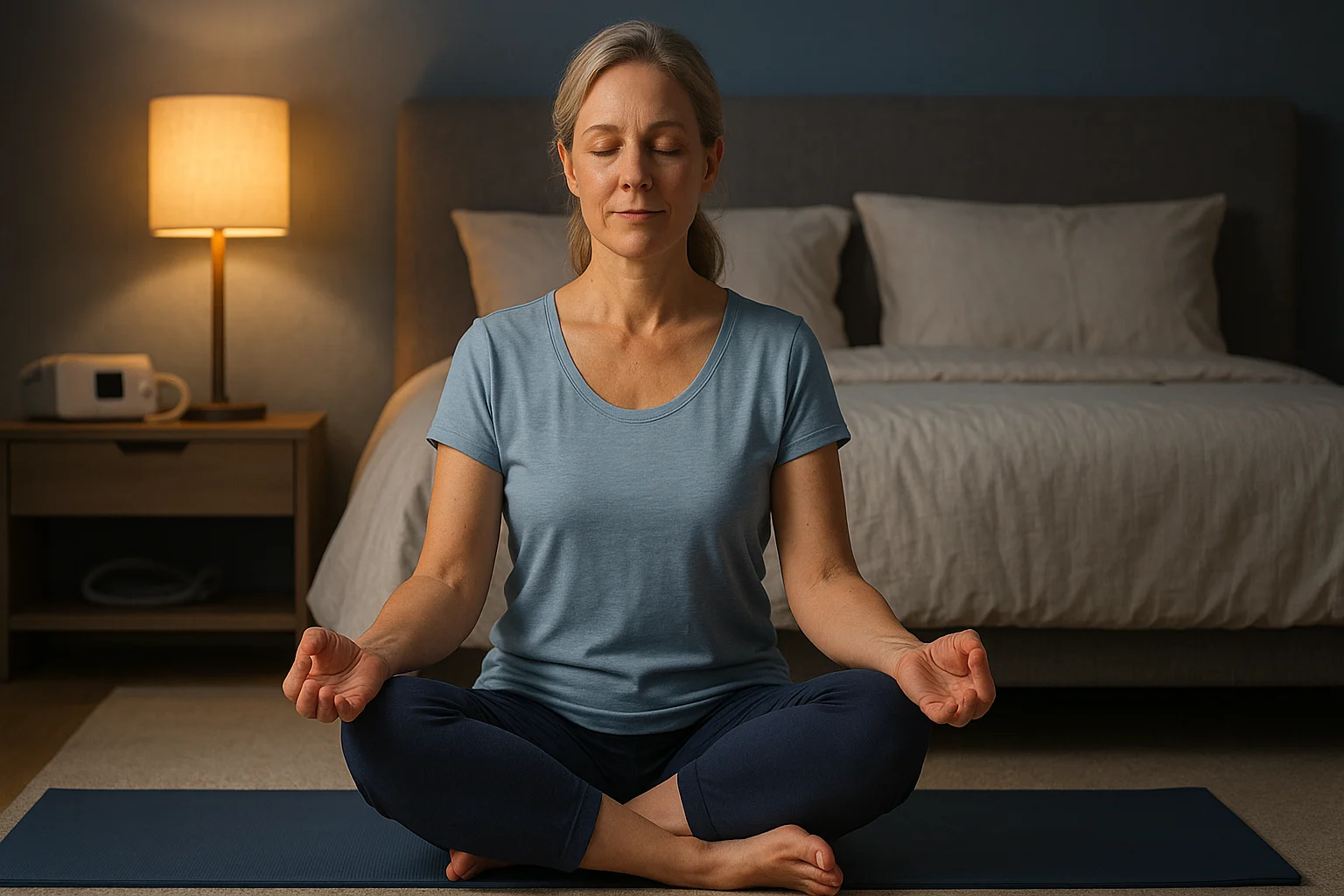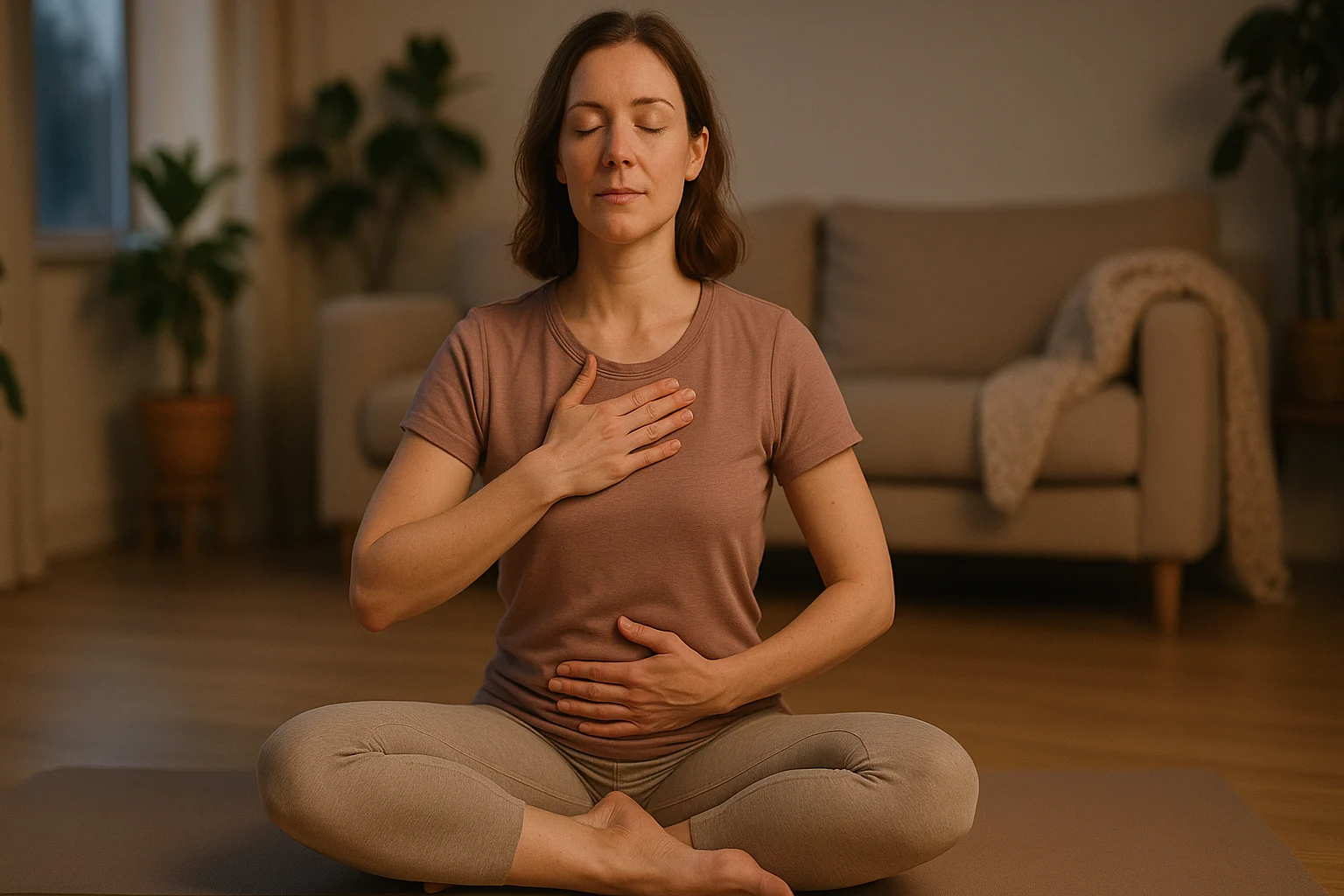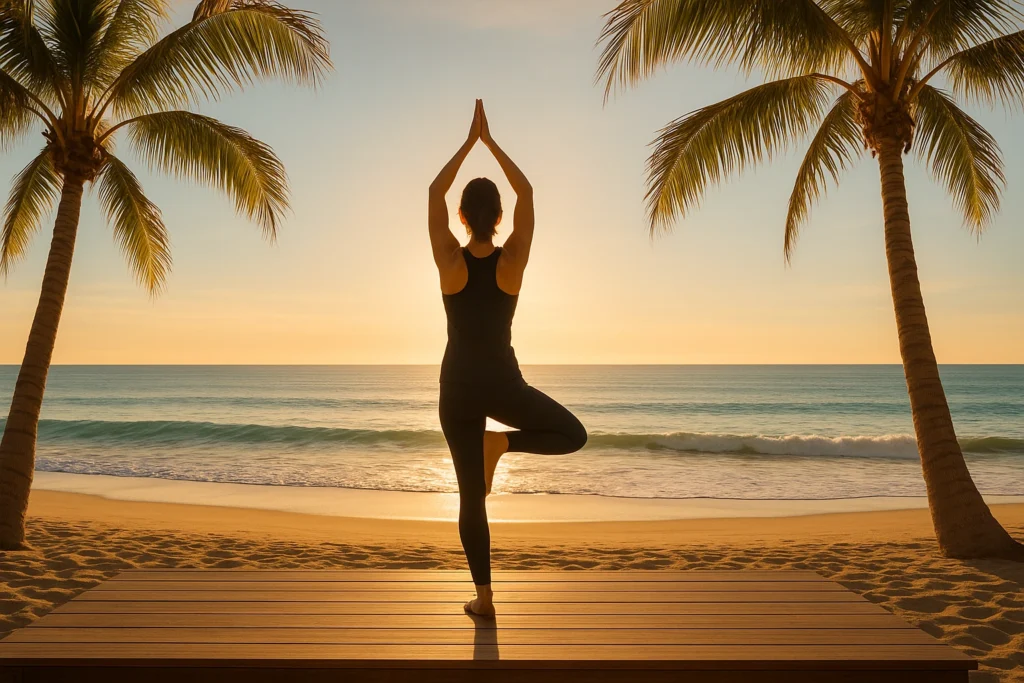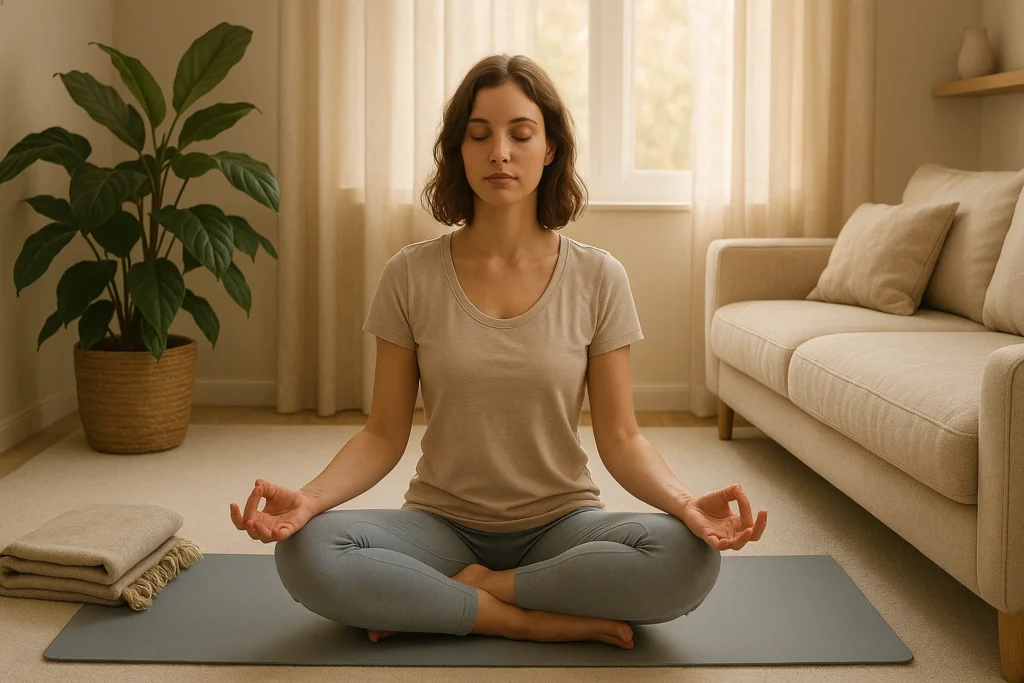
Struggling to sleep because of sleep apnea? Sleep apnea yoga—simple bedtime poses and breathing—may help you breathe easier and support deeper sleep. Sleep apnea causes breathing pauses at night that leave you exhausted and raise heart risks. CPAP is essential for many; yoga works alongside it. By linking mind, body, and breath, this practice may help tone airway muscles, support respiratory function, and calm your nervous system. For a broader look at how yoga supports specific conditions, see our guide on yoga specialized health.
Quick definition: “Sleep apnea yoga” is gentle, breath-led yoga done before bed to relax the nervous system and help keep airways open—used as a complement to CPAP or other treatments, not a replacement.
Find Your Perfect Yoga Routine!Table of Contents
- Understanding the Condition & How Yoga Helps
- Safety Tips Before You Start
- Breathing Techniques (Pranayama)
- 5 Calming Bedtime Poses
- Build Your Nightly Routine
- Whole-Body Tips for Better Sleep
- Success Story: Sarah
- Bedtime Breathing Quiz
- Yoga for Apnea: Frequently Asked Questions
- Conclusion: Breathe Easier with Yoga
Sleep Apnea Yoga: How It Helps (and What Sleep Apnea Is)
Before you begin a yoga routine for sleep apnea, here’s a quick look at the condition and why this approach helps.
What is sleep apnea?
Sleep apnea disrupts breathing during sleep. Obstructive Sleep Apnea (OSA), the most common type, occurs when throat muscles relax, narrowing the airway. Central Sleep Apnea (CSA) stems from the brain failing to signal breathing muscles. Symptoms include:
- Loud snoring or gasping
- Frequent waking
- Daytime fatigue
- Headaches or irritability
Untreated, it risks high blood pressure, heart issues, or diabetes.
Why yoga for apnea works
Yoga, especially breath-focused pranayama, supports sleep apnea, as shown in studies on yoga’s respiratory benefits. Here’s why:
- May strengthen airway support: May help tone throat and soft-palate muscles, which may reduce airway collapse.
- Supports efficient breathing: May improve respiratory efficiency and steadier breathing.
- May ease inflammation: May help ease stress-related inflammation and airway irritation; research is emerging.
- Promotes relaxation: Calms the nervous system, which may improve sleep quality. Learn more in our guide on yoga for stress relief.
- Supports healthy habits: As part of a broader routine, yoga can support habits that may lessen symptoms.
“Yoga isn’t just stretching; it’s a pathway to better breathing and deeper rest.”

Sleep Apnea Yoga Safety: Before You Start
This bedtime practice complements—never replaces—medical treatment for sleep apnea. Check with your doctor or sleep specialist before starting, especially for severe cases. Keep using CPAP or other therapies. Move gently, stop if anything hurts, and build up gradually.
Breathing Techniques for Sleep Apnea
Pranayama works like strength training for your breathing muscles and a brake for a busy mind. Start with the two simple techniques below, or explore more in our beginner breathwork guide:
This post has affiliate links. We may earn a commission. Learn more.
Diaphragmatic breathing (belly breathing)
Why it helps:
- Lets your diaphragm do the heavy lifting so airflow stays steady—even when you’re tired.
- Makes each inhale feel easier and more efficient.
- Engages the parasympathetic “rest and digest” response so your body actually unwinds.
How to do it:
- Lie on your back with knees bent (or sit upright). Place one hand on your chest and one on your belly.
- Breathe in through your nose and let your belly rise while the chest stays mostly still.
- Exhale slowly through the nose or mouth and let the belly fall.
- Continue for 5–10 minutes, picturing a smooth, even wave.
Tips: Practice daily. If your chest keeps lifting, soften the breath and send it lower into the belly.
Nadi Shodhana (alternate nostril breathing)
Why it helps:
- Quiets mental chatter and eases stress.
- Opens nasal passages and builds awareness of the breath.
- Creates a balancing rhythm—useful when you feel wired or scattered.
How to do it:
- Sit tall. With the right hand, rest index and middle fingers between the brows; use the thumb to close the right nostril and the ring finger to close the left.
- Close the right nostril and inhale through the left. Close the left and exhale through the right.
- Inhale through the right, close it, and exhale through the left. That’s one round—repeat for 5–10 rounds.
Tips: Keep the breath light and unforced. If you’re stuffy, imagine the air flowing smoothly.
5 Bedtime Yoga Poses to Relieve Sleep Apnea
These calming poses open the chest and throat for restful sleep:
| Pose | Benefits | Duration |
|---|---|---|
| Supine Bound Angle | Opens chest, relaxes hips | 5–10 min |
| Legs Up the Wall | Calms mind, reduces leg swelling | 5–15 min |
| Child’s Pose | Promotes diaphragmatic breathing | 3–5 min |
| Neck & Shoulder Stretches | Releases tension, opens throat | 3–5 min |
| Corpse Pose | Promotes full-body relaxation | 5–10 min |
1. Supine Bound Angle Pose (Supta Baddha Konasana)
Why it helps:
- Relaxes the nervous system.
- Opens hips and chest for easier breathing.
- Improves circulation.
How to do it:
- Lie on back. Bring soles together, knees outward.
- Support knees with pillows. Rest arms by sides or on belly/heart.
- Breathe deeply 5–10 minutes, letting hips soften.
Tips: Use a bolster under spine for chest opening.
2. Legs Up the Wall Pose (Viparita Karani)
Why it helps:
- Takes the edge off anxious energy.
- Reduces leg swelling, which may lessen fluid shifting toward the airway at night.
- Encourages easy circulation and a relaxed heart rate.
How to do it:
- Sit with one hip at the wall and swing your legs up so your body forms an L shape.
- Slide a pillow under your hips if it feels good, and let your arms rest by your sides.
- Stay 5–15 minutes and let the breath be natural.
Tips: No clear wall? Rest your calves on a chair.
3. Child’s Pose (Balasana)
Why it helps:
- Makes belly-breathing feel natural and steady.
- Takes pressure off the back and quiets stress.
- Helps you feel grounded and safe.
How to do it:
- Kneel, bring your big toes together, and widen the knees. Fold your torso forward.
- Rest your forehead on the mat or a pillow; stretch your arms forward or tuck them by your sides.
- Breathe into the back and belly for 3–5 minutes.
Tips: If your hips or back are sensitive, hug a bolster under your chest. For more restorative shapes, see our recovery yoga guide.
4. Gentle neck & shoulder stretches
Why it helps:
- Softens tight muscles around the throat and shoulders that can make breathing feel restricted.
- Encourages fresh blood flow through the neck and upper back.
- Can ease tension headaches and jaw clenching from the day.
How to do it:
- Sit comfortably. Roll the shoulders 5–10 times forward, then 5–10 back.
- Drop your right ear toward your right shoulder; hold for 3 easy breaths. Switch sides. Repeat 3–5 rounds.
- Look left, then right; finally lower chin to chest. Take 3–5 slow reps each.
- Draw the shoulder blades together gently; hold for one smooth breath and release. Repeat 5–8 times.
Tips: Move slowly, avoid forcing stretches.
5. Corpse Pose (Savasana)
Why it helps:
- Promotes full-body relaxation.
- May help lower stress and support healthy blood pressure.
- Prepares for deep sleep.
How to do it:
- Lie flat, legs extended, feet falling outward.
- Rest arms by sides, palms up. Use pillow under head/knees if needed.
- Breathe naturally, relax 5–10 minutes.
Tips: Try a guided body scan for deeper relaxation.
Build Your Nightly Routine
Small and steady wins—a few minutes most nights beats one long session once a week. Try this:
- Timing: Aim for 30–60 minutes before lights out.
- Duration: Begin with 10–15 minutes; grow to 20–30 as it feels right.
- Environment: Dim the lights, park the screens, maybe add a hint of lavender.
- Flexibility: On low-energy nights, let Savasana be the star.
- Track progress: Jot down sleep quality and next-day energy.
Holistic Tips to Support Sleep Apnea (with Yoga)
Pair your bedtime yoga with these small tweaks:
- Keep a steady schedule: same sleep and wake time—even weekends.
- Tune your bedroom: blackout curtains, a cool room, and a wedge or body pillow for side-sleeping.
- Fade the blue light: skip screens 1–2 hours before bed to support melatonin.
- Evening diet: go light and avoid late caffeine or alcohol.
- Hydration: front-load water earlier so you’re not up all night.
- Weight management: if relevant, talk with your doctor about a gentle plan.
- Side sleeping: a body pillow can keep you comfortably on your side.
For more on creating a calming sleep environment, check our Ayurvedic daily practices guide.
Real-Life Impact: Sarah’s Story
Sarah, 48, has moderate sleep apnea and still felt wiped out even with CPAP. She gave a 20-minute wind-down a try—diaphragmatic breathing, Legs Up the Wall, then Savasana. After two weeks she was falling asleep faster. By week four her partner noticed less snoring, and she woke up clearer. “Yoga complements my CPAP,” she says. “My breathing feels stronger and I finally feel rested.”
“Yoga helped me breathe easier at night.” – Sarah, 48
Bedtime Breathing Quiz
Take this quick, 3-question quiz to get a bedtime yoga routine that fits you:
Quick 3-Question Check-In
Answer a few prompts and we’ll suggest a simple plan.
How severe is your sleep apnea?
Yoga for Apnea: Frequently Asked Questions
Conclusion: Breathe Easier with Yoga
By adding a gentle yoga practice for sleep apnea to your nightly routine, you can support more restful sleep. These poses and breathing exercises may help strengthen your respiratory system, open airways, and relax your mind. Used alongside medical treatment and steady sleep habits, yoga can help you wake up clearer and more rested. Start small, keep it consistent, and give it a few weeks to feel the difference.


